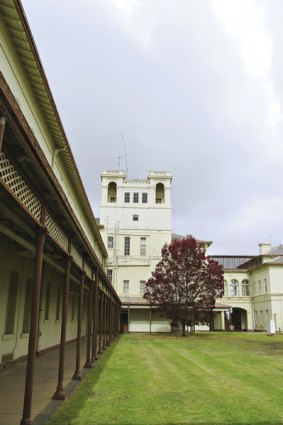
Life inside ... a tour of Aradale takes in the chapel, dining room and wards.
Local legend has it that an Ararat businessman running late for a Christmas concert arrived at the formidable gates of the Aradale Mental Hospital to find them locked. A man on the other side, a patient, pulled some wire from his pocket, unlocked the gates with it, let the latecomer in and relocked them.
The tale of the gates is just one of countless stories about the thousands of people confined at Aradale, originally called the Ararat Lunatic Asylum, since it was built in 1863.
A labyrinth of 63 mostly Victorian buildings, Aradale is a forgotten mini-metropolis high on a hill above Ararat, 205 kilometres west of Melbourne. We're among the first visitors to the 100-hectare complex since its dormitories, dining halls and sprawling grounds were emptied of its last patients in 1993.
Aradale has been lying largely empty for 16 years and is a desolate place. Walking across its deserted grounds is like walking onto a film set from a horror movie post-apocalypse: leaves swirl across empty courtyards a few birds hop around an unfilled swimming pool, downpipes rattle and wind blusters around the asylum's old towers.
In days gone by anyone old and young, male and female who had a mental illness or a condition such as epilepsy, autism or Down Syndrome, could find themselves in an institution such as Aradale.
Those deemed criminally insane were housed at J Ward, a network of grim bluestone buildings two kilometres away in Ararat. A goldfields prison dating from 1859, J Ward was acquired by the Lunacy Department in 1886 and became Aradale's maximum security ward until its closure in 1991.
For many people, the imposing Italianate buildings, once busy with up to 1000 patients cared for by 500 staff, was the only home they knew; in the past people committed to asylums such as Aradale generally stayed there for life.
Bill Wallace, a suspected murderer who spent 57 years at J Ward and seven years at Aradale, was one of them. Although never tried or convicted for allegedly murdering a friend following an argument over a cigarette in King Street, Melbourne, Wallace was declared "insane" by two doctors in 1925 and "held at the Governor's pleasure" for the next 64 years. He died at Aradale in 1989, aged 107.
A small whirly-wind kicks up the flotsam and jetsam of the derelict grounds as we stroll across quadrangles studded with magnificent trees, including Irish yews, majestic oaks, cypress and colossal peppercorns. In its heyday, Aradale was considered a fine example of a mental institution in an era when doctors believed that restful quiet and country air were beneficial to the cure or control of mental illnesses.
The institution was designed as a self-sustaining village, with its own market gardens, orchard, vineyard, dairy and piggery. As well as 18 wards for patients, there was a chapel, carpentry, engineering, printing and upholstery workshops, a fire station and a gloomy morgue, all bounded by a wall a fence fronted by a deep trench that looks low and unthreatening on the outside, yet impossible to scale from the inside.
Tour guides Keith Lewis and Alex Beveridge lead us into a grand hall once used for dining, dances and film screenings, and on to a huge, dark room, the cavernous shell of what was the kitchen. We wander along empty halls past treatment rooms, endless stark white-painted bedrooms and dormitories with high ceilings and cracked linoleum and nurses' stations.
If Aradale's walls could talk, they would tell thousands of stories about people whose illnesses or idiosyncrasies landed them there, about how treatment of mental illnesses has altered dramatically since the mid-20th century.
Highlighting the changing approaches to the treatment of mental illness from institutional confinement to medication and rehabilitation is one reason why the Friends of J Ward, a group of volunteers who have run tours of the former ward for the criminally insane since 1993, lobbied for three years to run similar tours of Aradale, according to its president John Mason.
A rare glimpse into a slice of Victorian medical history, the eerie yet fascinating tours are a joint initiative of the Friends of J Ward and Northern Melbourne Institute of TAFE, which acquired Aradale in 2002 and now operate its Ararat campus from a few buildings on the site.
While NMIT has a vineyard, olive grove and lavender farm at Aradale, the extensive asylum buildings are in disrepair. The Friends of J Ward hope the 90-minute tours will draw wider attention to Aradale and spark efforts to preserve its 146-year-long history.
Aradale has tours on Sundays at 11am and 2pm, which cover the chapel, dining room, wards, morgue, kitchen, wall and grounds. Cost is $20 adults, $10 children. Ararat Visitor Information Centre, phone 1800 657 158.
Sign up for the Traveller Deals newsletter
Get exclusive travel deals delivered straight to your inbox. Sign up now.